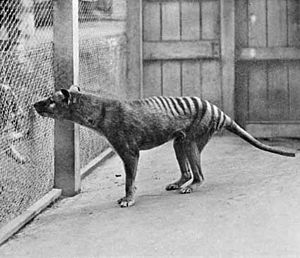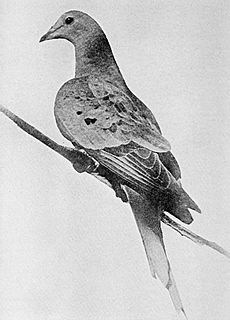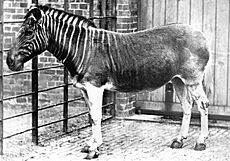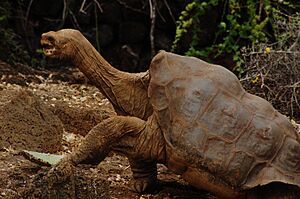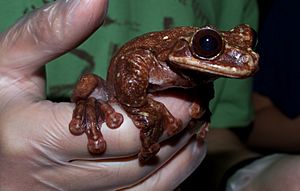Endling facts for kids
An endling is the very last known individual of a species or subspecies. When an endling dies, that species becomes extinct, meaning it no longer exists anywhere on Earth. The word "endling" was first suggested in letters published in the scientific journal Nature.
Contents
What is an Endling?
The word "endling" was first suggested in the science journal Nature in April 1996. People thought a new word was needed to describe the very last animal or plant of its kind.
The word "endling" was later used at the National Museum of Australia in an exhibition called Tangled Destinies in 2001. It was printed in large letters above two specimens of the extinct Tasmanian tiger. The definition said: "Endling (n.) The last surviving individual of a species of animal or plant."
In a book about Australian birds, author Libby Robin explained that scientists use "endling" to mean "the very last individual of a species." The word has also appeared in other publications, like the Earth Island Journal, where it was defined as "the last known specimen of her species." Many people find the idea of an endling sad, as it marks the final moment a species exists.
Famous Endlings: The Last of Their Kind
This section shares stories of some well-known endlings. These are individuals whose deaths marked the end of their entire species.
Birds: The Last Song
- The passenger pigeon (Ectopistes migratorius) became extinct on September 1, 1914. This happened when Martha, the last known member of her species, died at the Cincinnati Zoo.
- Incas, the last known Carolina parakeet (Conuropsis carolinensis), also died at the Cincinnati Zoo. This happened on February 21, 1918. The species was officially declared extinct in 1939.
- Booming Ben was a lonely heath hen (Tympanuchus cupido cupido). He was last seen on March 11, 1932, on Martha's Vineyard, Massachusetts.
- Orange Band was the last known dusky seaside sparrow (Ammodramus maritumus nigrescens). He died on June 17, 1987, at the Discovery Island zoological park at Walt Disney World Resort.
Mammals: A Final Farewell
- In 1627, the last aurochs (Bos primigenius) died in a forest in what is now Poland. Aurochs were ancient ancestors of today's cattle.
- The quagga (Equus quagga quagga) became extinct in the wild in the late 1870s. People hunted them for their meat and skins. The last quagga died in captivity on August 12, 1883, at the Artis zoo in Amsterdam.
- On September 7, 1936, the last known captive thylacine (Thylacinus cynocephalus) died at Hobart Zoo. This animal was also called the Tasmanian tiger. It died after its species had been hunted and trapped for many years. This thylacine was a male, captured in Tasmania in 1930. It was a very important animal at the zoo and died of old age. Even though some thought thylacines might have lived in the wild after this, the Hobart Zoo thylacine is seen as the endling for its species.
- Celia, the last Pyrenean ibex (Capra pyrenaica pyrenaica), was found dead on January 6, 2000. She was in the Spanish Pyrenees. Hunting and competition from farm animals had reduced her population to just one.
Reptiles and Amphibians: The Last Breath
- On June 24, 2012, Lonesome George died in his home in the Galápagos Islands. He was the last known Pinta Island tortoise (Chelonoidis niger abingdonii).
- Until September 26, 2016, the Atlanta Botanical Garden was home to Toughie. Toughie was the last known surviving Rabbs' fringe-limbed treefrog (Ecnomiohyla rabborum).
- A Fernandina Island Galápagos tortoise was found in 2019. This was exciting because the species was thought to be extinct for 113 years. However, this female is the only confirmed individual found so far.
Invertebrates: Tiny Last Ones
- Turgi was the last Partula turgida, a type of Polynesian tree snail. Turgi died on January 31, 1996, at the London Zoo.
- A tank at the Bristol Zoo was the last home for Partula faba, a land snail from French Polynesia. The number of these snails dropped from 38 in 2012 to just one in 2015. The last individual died on February 21, 2016.
- George was the last known individual of the Oahu tree snail species Achatinella apexfulva. He died on January 1, 2019, while in captivity near Kailua, Hawaii.
Plants: The Final Bloom
- The Curepipe Botanic Gardens in Mauritius have had the last specimen of the palm Hyophorbe amaricaulis since the 1950s.
- Pennantia baylisiana has only ever been known from one wild tree. This tree is still alive today. Other trees have been grown from clones of this single tree.
- Only one individual of the Wood's cycad (Encephalartos woodii) has existed since it was discovered in 1895. All other examples are clones grown from this single male plant.
- Only one living specimen of the tree species Madhuca diplostemon is known to exist.
See also
- Anthropocene
- Conservation status
- De-extinction
- Extinction
- Frozen zoo (places that store genetic material from animals, sometimes from endlings)
- Holocene extinction
- Lists of extinct animals
- List of new words
- Rare species
- Terminal speaker


